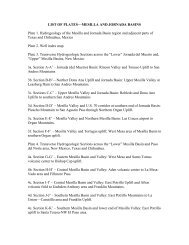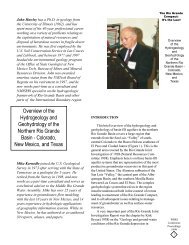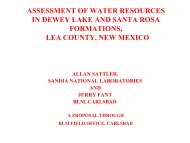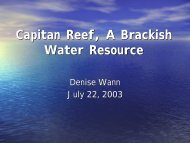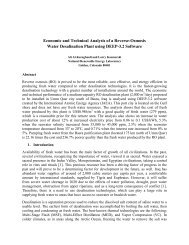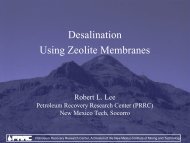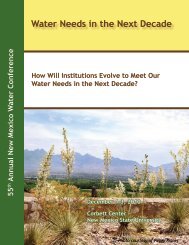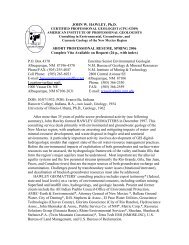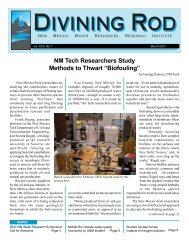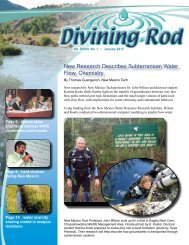Vol. XXX, No. 2 - Water Resources Research Institute - New Mexico ...
Vol. XXX, No. 2 - Water Resources Research Institute - New Mexico ...
Vol. XXX, No. 2 - Water Resources Research Institute - New Mexico ...
Create successful ePaper yourself
Turn your PDF publications into a flip-book with our unique Google optimized e-Paper software.
<strong>Vol</strong>. <strong>XXX</strong>, <strong>No</strong>. 2 June 2007<br />
<strong>Research</strong>ers develop low-cost,<br />
low-energy desalination process<br />
by Karl Hill, NMSU University Communications<br />
NMSU civil engineering professor Nirmala<br />
Khandan, right, and doctoral student Veera<br />
Gnaneswar (John) Gude check the control center<br />
of their prototype water desalination project.<br />
Operational data can be downloaded onto a laptop<br />
computer. (NMSU photo by Ben LaMarca)<br />
A low-cost water desalination system developed by <strong>New</strong> <strong>Mexico</strong><br />
State University engineers can convert saltwater to pure drinking water<br />
on a round-the-clock basis – and its energy needs are so low it can be<br />
powered by the waste heat of an air conditioning system.<br />
A prototype built on the NMSU campus in Las Cruces can produce<br />
enough pure water continuously to supply a four-person household, said<br />
Nirmala Khandan, an environmental engineering professor in NMSU’s<br />
Department of Civil Engineering.<br />
<strong>New</strong> <strong>Mexico</strong> and other parts of the world have extensive brackish<br />
groundwater resources that could be tapped and purified to augment<br />
limited freshwater supplies, but traditional desalination processes such<br />
as reverse osmosis and electrodialysis consume significant amounts of<br />
energy.<br />
This research project, funded by the <strong>New</strong> <strong>Mexico</strong> <strong>Water</strong> <strong>Resources</strong><br />
<strong>Research</strong> <strong>Institute</strong>, explores the feasibility of using low-grade heat –<br />
such as solar energy or waste heat from a process such as refrigeration<br />
or air conditioning – to run a desalination process.<br />
Khandan said the project builds on a process, first developed by<br />
researchers in Florida, that makes distillation of saline water possible at<br />
relatively low temperatures – 45 to 50 degrees Celsius (113 to 122<br />
degrees Fahrenheit) rather than the 60 to 100 C (140 to 212 F) required<br />
by most distillation processes.<br />
The system utilizes the natural effects of gravity and atmospheric<br />
pressure to create a vacuum in which water can evaporate and condense<br />
at near-ambient temperatures. Two 30-foot vertical tubes – one rising<br />
from a tank of saline water and the other from a tank of pure water – are<br />
connected by a horizontal tube. The barometric pressure of the tall water<br />
columns creates a vacuum in the headspace.<br />
(continued on page 2)<br />
INSIDE<br />
2007 Annual <strong>New</strong> <strong>Mexico</strong> <strong>Water</strong><br />
Conference Program Page 3<br />
ENMU students conduct water<br />
research Page 6<br />
<strong>New</strong> <strong>Mexico</strong> middle and high school<br />
students display projects Page 8
(continued from page 1)<br />
At normal temperatures, Khandan said, evaporation from<br />
the pure-water side will travel to the saline side and condense<br />
as the system<br />
seeks equilibrium.<br />
“That’s nature,” he<br />
said. “We want it<br />
to go the other<br />
way.”<br />
Raising the<br />
temperature of the<br />
water in the<br />
headspace over the<br />
saline column<br />
slightly more than<br />
that of the<br />
freshwater column<br />
causes the flow to<br />
go in the other<br />
direction, so that<br />
pure, distilled<br />
water collects on<br />
one side and the<br />
brine concentrate<br />
is left behind in a<br />
separate container.<br />
A temperature<br />
increase of only 10 to 15 degrees is needed, Khandan said.<br />
“That’s the trick of this vacuum,” he said. “We don’t have<br />
to boil the water like normal distillation, so you can use lowgrade<br />
heat like solar energy or waste heat from a diesel engine<br />
or some other source of waste heat.”<br />
Potentially a desalination system using this method could<br />
be coupled to a home’s refrigerated air conditioning system,<br />
Khandan said.<br />
“When you air condition a house, you are pumping the<br />
heat outside the house, and the heat is wasted into the<br />
atmosphere,” he said. “We want to capture that heat and use<br />
it to power this desalination system.”<br />
The 30-foot-tall NMSU prototype is powered by a solar<br />
panel. Khandan and his research assistant, civil engineering<br />
doctoral student Veera Gnaneswar Gude, have modified the<br />
process originally developed by Florida researchers to<br />
incorporate a thermal energy storage device that allows the<br />
system to operate around-the-clock, using stored energy at<br />
night. The <strong>Institute</strong><br />
of Energy and<br />
Environment<br />
housed in the<br />
NMSU College of<br />
Engineering<br />
helped them<br />
instrument the<br />
system.<br />
Their research<br />
on the system’s<br />
capabilities has<br />
been presented at<br />
national and<br />
international<br />
conferences and<br />
their research<br />
continues.<br />
As with any<br />
desalination<br />
A photovoltaic module (in the foreground) captures the last rays of the sun to produce<br />
electricity, which is used to drive this desalination process (in the background).<br />
(Photo by N. Khandan)<br />
process, the<br />
system leaves<br />
behind a brine<br />
concentrate that<br />
must be disposed of, and some potential users may be put off<br />
by the unit’s height, “but this technology could go to<br />
commercial scale pretty quickly,” Khandan said. “The overall<br />
cost of desalination by this process can be very competitive.”<br />
The project is one of many research initiatives at NMSU<br />
aimed at addressing the critical needs of <strong>New</strong> <strong>Mexico</strong> and<br />
the nation. It has been presented at several meetings including<br />
the 3rd International Conference on Thermal Engineering:<br />
Theory and Applications in Amman, Jordan in May 2007.<br />
Dr. Khandan has submitted a proposal to the National<br />
Science Foundation’s Integrative Graduate Education and<br />
<strong>Research</strong> Trainee Program (IGERT) to develop an energy<br />
program that includes this project.<br />
CLE has approved 8.7 general continuing legal education credits for the<br />
52nd Annual <strong>New</strong> <strong>Mexico</strong> <strong>Water</strong> Conference<br />
2
52nd Annual <strong>New</strong> <strong>Mexico</strong> <strong>Water</strong> Conference<br />
Beyond the Year of <strong>Water</strong>: Living within Our <strong>Water</strong> Limitations<br />
<strong>No</strong>vember 29 - 30, 2007; Santa Fe La Fonda<br />
10:00 Break<br />
Thursday Morning,<br />
<strong>No</strong>vember 29, 2007<br />
8:15 Introduction by Karl<br />
Wood, WRRI Director<br />
Welcoming Remarks by Santa<br />
Fe Mayor David Coss<br />
8:45 Keynote Address: What<br />
Happens after the Year of<br />
<strong>Water</strong>? <strong>New</strong> <strong>Mexico</strong> Lt. Gov.<br />
Diane Denish (invited)<br />
9:30 USGS <strong>Water</strong> Programs<br />
and Initiatives<br />
Mark Myers, Director, U.S. Geological Survey<br />
10:30 Update on the State of the State’s <strong>Water</strong><br />
John D’Antonio, NM State Engineer<br />
11:00 <strong>New</strong> <strong>Mexico</strong> Indian <strong>Water</strong> Rights Settlements and<br />
Their Economic Impact on Tribes and Pueblos<br />
Chairman Joe Garcia, All Indian Pueblo Council<br />
11:30 Preview of Legislative <strong>Water</strong> Issues 2008<br />
<strong>New</strong> <strong>Mexico</strong> Representative Andy Nunez, Chair,<br />
Committee on Agriculture and <strong>Water</strong> <strong>Resources</strong><br />
12:00 Lunch on Your Own<br />
Thursday Afternoon, <strong>No</strong>vember 29, 2007<br />
1:30 Demographics and <strong>Water</strong> Demand in <strong>New</strong> <strong>Mexico</strong><br />
and the Southwest<br />
Adelamar Alcantara, Bureau of Business and<br />
Economic <strong>Research</strong>, University of <strong>New</strong> <strong>Mexico</strong><br />
2:00 Market Prices as Measures of <strong>Water</strong> Scarcity in<br />
<strong>New</strong> <strong>Mexico</strong> and the West<br />
F. Lee Brown, University of <strong>New</strong> <strong>Mexico</strong><br />
2:30 A Living River Fund<br />
John Horning, Forest Guardians<br />
3:00 Break<br />
3:30 Western Agriculture at Risk from Climate Change<br />
and Competing <strong>Water</strong> Demands<br />
Pat O’Toole, Family Farm Alliance<br />
4:00 Panel Discussion: The Federal Perspective and<br />
Initiatives on <strong>Water</strong><br />
Moderated by Karl Wood, WRRI Director<br />
Mike Connor for Senator Jeff Bingaman<br />
Zane Vaughn for Senator Pete Domenici<br />
Tim Charters for Congressman Steve Pearce<br />
Matt Miller for Congressman Tom Udall<br />
Robert Cushing for Congresswoman Heather<br />
Wilson<br />
5:00 Reception hosted by Daniel B. Stephens &<br />
Associates<br />
6:30 Dinner Banquet<br />
Friday Morning, <strong>No</strong>vember 30, 2007<br />
8:30 Climate <strong>Research</strong> and Applications Needs in<br />
Support of Climate Services<br />
Roger Pulwarty, National Oceanic and Atmospheric<br />
Administration<br />
9:00 Governor’s Task Force Report on Climate Change<br />
David Gutzler, University of <strong>New</strong> <strong>Mexico</strong><br />
9:30 Climate Change and Its Implications for <strong>New</strong><br />
<strong>Mexico</strong>’s <strong>Water</strong> <strong>Resources</strong> and Economic<br />
Opportunities<br />
Brian Hurd, <strong>New</strong> <strong>Mexico</strong> State University<br />
10:00 Break<br />
10:30 What to Do with <strong>Water</strong> Left Over after<br />
Needs are Met?<br />
Bob Grant, Grant Enterprises, Inc.<br />
11:00 <strong>New</strong> <strong>Mexico</strong>’s EPSCoR Proposal to NSF Regarding<br />
Climate Effects on Mountain <strong>Water</strong> Supplies<br />
Albert Rango, USDA-ARS-Jornada Experimental<br />
Range, <strong>New</strong> <strong>Mexico</strong> State University<br />
11:30 <strong>Water</strong> Capital and <strong>Water</strong> Productivity – Ways to<br />
Address Fresh <strong>Water</strong> Availability Limitations<br />
Mike Hightower, Sandia National Laboratories<br />
Register online at wrri.nmsu.edu<br />
3
2007 <strong>New</strong> <strong>Mexico</strong><br />
<strong>Water</strong> <strong>Research</strong> Symposium<br />
Abstracts for Presentations and Posters<br />
Due July 6, 2007<br />
Submit abstracts and register for the symposium at<br />
http://wrri.nmsu.edu/conf/tc07/symposium.html<br />
Macey Center<br />
<strong>New</strong> <strong>Mexico</strong> Tech<br />
August 14, 2007<br />
4<br />
<strong>New</strong> Home for NMSU’s SCERP Office<br />
Erin M. Ward, <strong>New</strong> <strong>Mexico</strong> director of the Southwest<br />
Consortium for Environmental <strong>Research</strong> and Policy (SCERP),<br />
is pleased to announce the relocation of the SCERP research<br />
consortium to the offices of WRRI in Stucky Hall. The move<br />
is designed to leverage the strengths of the two research centers<br />
while improving administrative efficiency for research and<br />
grant support.<br />
“I see this as a win-win,”<br />
says Ward. “It’s a perfect match<br />
for the SCERP program, which<br />
will benefit from the <strong>Institute</strong>’s<br />
excellent reputation, its<br />
infrastructure, and superb staff.<br />
Likewise, the move<br />
strengthens capabilities at<br />
WRRI by extending the<br />
<strong>Institute</strong>’s reach into U.S.-<br />
<strong>Mexico</strong> border communities.”<br />
The SCERP program is<br />
significant for obtaining<br />
federal authorization that<br />
allows U.S.-based researchers<br />
to spend U.S. research dollars<br />
in <strong>Mexico</strong>.<br />
The SCERP consortium is an 18-year-old collaboration<br />
of five U.S. and five Mexican institutions of higher education<br />
whose original mission was to address problems faced by<br />
communities at the U.S.-<strong>Mexico</strong> border. Recently, the<br />
consortium increased its funding for projects in the areas of<br />
Erin Ward (left) and graduate student assistant Edgar<br />
Barrantes relocated with the SCERP program to the<br />
WRRI.<br />
water quality, water conservation, water planning, and<br />
mapping of groundwater resources in the border region.<br />
The SCERP consortium has earned a number of<br />
community and research honors, including an award from the<br />
prestigious Charles Lindberg Foundation and the Smithsonian<br />
Institution in Washington. Recently, the Consortium was cited<br />
by EPA as one of the nation’s top water research entities for<br />
an arsenic-removal project<br />
conducted in Columbus, NM.<br />
SCERP has received the<br />
endorsement of <strong>New</strong> <strong>Mexico</strong>’s<br />
border communities and the<br />
Border Trade Alliance (BTA),<br />
a U.S.-<strong>Mexico</strong> and U.S.-<br />
Canada trade organization. At<br />
NMSU, SCERP researchers are<br />
active in NMSU’s Border and<br />
<strong>Water</strong> research clusters and subclusters.<br />
Universities with membership<br />
in SCERP include Arizona<br />
State University, <strong>New</strong> <strong>Mexico</strong><br />
State University, San Diego<br />
State University, the University<br />
of Texas at El Paso, and the University of Utah. The<br />
consortium’s Mexican partners are El Colegio de la Frontera<br />
<strong>No</strong>rte, Instituto Tecnológico de Ciudad Juárez, Instituto<br />
Tecnológico y de Estudios Superiores de Monterrey,<br />
Universidad Autónoma de Baja California, and Universidad<br />
Autónoma de Ciudad Juárez.
2007-2008 Student <strong>Water</strong> <strong>Research</strong> Grant Program<br />
deadline for proposals July 8, 2007<br />
The <strong>New</strong> <strong>Mexico</strong> <strong>Water</strong> <strong>Resources</strong> <strong>Research</strong> <strong>Institute</strong> has announced the 2007-2008 Student<br />
<strong>Water</strong> <strong>Research</strong> Grant Program. This program encourages and supports graduate and<br />
undergraduate student research in disciplines relevant to water resources issues and assists<br />
<strong>New</strong> <strong>Mexico</strong> institutions of higher education in developing student research expertise and<br />
capabilities.<br />
Proposals must have a faculty sponsor and students must be enrolled full-time in a degree<br />
program at one of <strong>New</strong> <strong>Mexico</strong>’s six public education institutions (NMSU, UNM, NMT,<br />
ENMU, WNMU, or NMHU). The faculty sponsor is responsible for ensuring that the<br />
proposal has been processed according to their university’s proposal submission policies<br />
and procedures.<br />
WRRI’s goal is to fund a minimum of two research projects at each <strong>New</strong> <strong>Mexico</strong> institution,<br />
with each award no greater than $5,000 for the project period. It is anticipated that grants<br />
will start on August 15, 2007 with final reports due September 30, 2008.<br />
To get more information on the program and to submit a proposal, go to http://wrri.nmsu.edu/<br />
research/rfp/studentgrants07/stgr.html<br />
WRRI students graduate<br />
Three <strong>New</strong> <strong>Mexico</strong> State University<br />
students who work in WRRI’s GIS lab<br />
completed degree programs in May<br />
2007. They work alongside several other<br />
students in the lab under the direction<br />
of Dr. Bobby Creel, WRRI Associate<br />
Director.<br />
Quita Ortiz has completed a master<br />
of applied geography degree. She<br />
successfully defended her thesis entitled<br />
“The Impacts of Land Use Change on<br />
<strong>Water</strong> <strong>Resources</strong> and Traditional<br />
Acequia Culture in <strong>No</strong>rth-central <strong>New</strong><br />
<strong>Mexico</strong>” in April. Quita received an<br />
NMSU <strong>Research</strong> Mini-Grant for the<br />
project and will publish the results of her<br />
study in the next issue of the Journal of<br />
Contemporary <strong>Water</strong> <strong>Research</strong> and<br />
Education. She has worked on various<br />
WRRI mapping projects for the past four<br />
years.<br />
Two other students who<br />
have been employed at the<br />
WRRI for the past year<br />
graduated with bachelor’s<br />
degrees in geography this<br />
spring. Susanna Glaze<br />
graduated with a B.A. in<br />
history and a B.S. in<br />
geography with a minor in<br />
GIS. She presented a project<br />
entitled “Rio Grande Basin Initiative:<br />
Interactive Mapping for <strong>New</strong> <strong>Mexico</strong>”<br />
at the Joint Rio Grande Basin Initiatives<br />
2007 Annual Conference in South Padre<br />
Island in May 2007. Susanna has been<br />
awarded an NMSU Graduate Student<br />
<strong>Research</strong> Grant that will allow her to<br />
continue working with Dr. Creel during<br />
her master’s program in applied<br />
geography.<br />
From left: Casey Gomez, Quita Ortiz, and Susanna<br />
Glaze.<br />
Casey Gomez majored in geography<br />
and earned minors in GIS and wildlife<br />
sciences. While at the WRRI, he worked<br />
on the U.S.-<strong>Mexico</strong> Geospatial Database<br />
mapping the border aquifers for the<br />
binational water aquifer project. Casey<br />
also assisted with deploying the<br />
Microsoft SQL and ESRI SDE. He<br />
hopes to find a GIS-related position,<br />
possibly with the federal government.<br />
5
ENMU Students Receive WRRI Grants for<br />
<strong>Water</strong> <strong>Research</strong><br />
by Erin Griffith, Communications Services, ENMU<br />
Two graduate students from Eastern<br />
<strong>New</strong> <strong>Mexico</strong> University are currently<br />
working on projects sponsored by the<br />
<strong>New</strong> <strong>Mexico</strong> <strong>Water</strong> <strong>Resources</strong> <strong>Research</strong><br />
<strong>Institute</strong>. Nicole Harings and Irene<br />
Roselli are pursuing an M.S. in biology<br />
with emphases in aquatic ecology and<br />
animal behavior.<br />
Irene Roselli was born and raised in Belen, <strong>New</strong><br />
<strong>Mexico</strong>. Before arriving at ENMU for graduate work,<br />
she earned a bachelor’s degree from <strong>New</strong> <strong>Mexico</strong> Tech<br />
in biology.<br />
Still in the data collection phase of<br />
their studies, both Harings and Roselli<br />
have already learned a large amount not<br />
only from their projects but also from<br />
applying for the grant.<br />
“Writing and obtaining the grant<br />
was very helpful because it shows<br />
people in the future that I am capable of<br />
doing so,” said Roselli, who received her<br />
B.S. in biology from <strong>New</strong> <strong>Mexico</strong> Tech.<br />
“It requires a lot of time and patience<br />
to sit and observe an organism for a long<br />
period of time to learn their typical<br />
6<br />
behaviors. I have already learned so well<br />
what needs to go into a good experiment<br />
and how a real research project works,”<br />
said Harings, who received her B.S.<br />
from the University of Wisconsin<br />
Stevens Point.<br />
Harings is studying tadpole shrimp<br />
and their effectiveness as a biological<br />
control agent<br />
against mosquito<br />
larvae. The<br />
tadpole shrimp<br />
are being tested<br />
in three<br />
conditions: a<br />
control where<br />
the shrimp are<br />
placed in<br />
water with<br />
no mosquito<br />
larvae, in<br />
water previously<br />
occupied by mosquito larvae,<br />
and in water with mosquito larvae<br />
present.<br />
“I wanted a project that I could do<br />
in a lab, and we have a lot of tadpole<br />
shrimp in our area. Whether or not it<br />
turns out that the tadpole shrimp prefer<br />
the mosquito larvae, the experiment is<br />
worthwhile,” Harings said.<br />
With the results of her study,<br />
Harings will be able to determine how<br />
well the tadpole shrimp will be able to<br />
deplete mosquito larvae in different<br />
conditions. In addition, the study might<br />
help researchers to know how plausible<br />
and economically efficient it will be to<br />
use tadpole shrimp against mosquito<br />
larvae.<br />
Because of the seasonal conflict,<br />
part of the grant money went to helping<br />
Harings bring in mosquitoes for her<br />
study.<br />
“Because I have to store tons of<br />
mosquitoes in the building, whenever<br />
anyone gets a mosquito bite, even if it<br />
wasn’t here, they blame me,” Harings<br />
said.<br />
Roselli is<br />
studying Daphnia<br />
(water fleas) and<br />
their reproductive<br />
habits when<br />
confronted with a<br />
predator. She is<br />
using the Daphnia<br />
as a model<br />
organism to see<br />
the habits of<br />
organisms when<br />
they are being<br />
preyed upon and<br />
Roselli’s field site is located at the Melrose how it affects the<br />
Migrant Trap in Melrose, <strong>New</strong> <strong>Mexico</strong>. prey population.<br />
“I am testing in areas of high<br />
predators, low predators and a control<br />
with no predators. With the results we<br />
will be able to see the survivorship<br />
strategy for the Daphnia and use the<br />
results to compare with other<br />
invertebrate and even vertebrae prey<br />
species,” Roselli said.<br />
(continued on page 7)
(continued from page 6)<br />
While she has not started analyzing<br />
her data yet, the trend Roselli sees is that<br />
Daphnia produce a larger amount of<br />
“Because I have to store<br />
tons of mosquitoes in the<br />
building, whenever anyone<br />
gets a mosquito bite, even<br />
if it wasn’t here, they blame<br />
me,” - Nicole Harings<br />
eggs more quickly when in an area of<br />
high predators, indicating that they<br />
allocate more energy to reproduction in<br />
that setting.<br />
“The project has been great; I’ve<br />
learned a lot, from how to write a grant,<br />
as well as how to carry out a large<br />
experiment in a lab,” Roselli said.<br />
After receiving their master degrees,<br />
Harings and Roselli wish to pursue a<br />
Ph.D. program. Harings is potentially<br />
looking at <strong>New</strong> <strong>Mexico</strong> State University.<br />
Upon receiving Ph.D.s, Roselli is<br />
interested in becoming a professor, while<br />
Harings would like to work with a nonprofit<br />
organization as a conservationist<br />
biologist.<br />
(continued from page 9)<br />
Española. His project was entitled<br />
“<strong>Water</strong>shed Watch.” Joe has participated<br />
in science fairs since 3rd grade.<br />
He credits his mother and Mr. Schraeder<br />
of the <strong>New</strong> <strong>Mexico</strong> Department of Game<br />
and Fish for their encouragement and<br />
assistance in his project.<br />
Second place in the Junior Division<br />
went to Jessica Rhodes of Las Cruces.<br />
She is an 8th grader at Sierra Middle<br />
School’s science magnet program.<br />
Jessica’s science teacher, Mr. Wibe<br />
encouraged her project, and she is<br />
thinking about studying science in<br />
college. Her project was entitled, “Got<br />
<strong>Water</strong>? The Effectiveness of Solid and<br />
Liquid Desiccants in Extracting <strong>Water</strong>.”<br />
Nicole Harings plans to defend her master’s thesis in June 2007.<br />
She is originally from Stevens Point, Wisconsin.<br />
2007 Upcoming Meetings<br />
June 9: Middle Rio Grande <strong>Water</strong> Assembly, UNM, Albuquerque, NM<br />
(www.<strong>Water</strong>Assembly.org)<br />
June 25-27: 2007 AWRA Summer Specialty conference – Emerging<br />
Contaminants of Concern in the Environment: Issues, Investigations, and<br />
Solutions, Vail Cascade Resort, Vail, CO (awra.org)<br />
August 6-7: <strong>New</strong> <strong>Mexico</strong> <strong>Water</strong> Law, Marriott Pyramid <strong>No</strong>rth, Albuquerque,<br />
NM (www.cle.com)<br />
August 14: 2007 <strong>New</strong> <strong>Mexico</strong> <strong>Water</strong> <strong>Research</strong> Symposium, NM Tech,<br />
Socorro, NM (http://wrri.nmsu.edu/conf/tc07/symposium.html)<br />
August 27-29: Symposium on the Settlement of Indian Reserved <strong>Water</strong><br />
Rights Claims, Hyatt Regency, Albuquerque, NM (http://www.westgov.org/<br />
wswc/meetings.html)<br />
August 29-Sept 1: SAHRA, Tucson, “Sustainable <strong>Water</strong>, Unlimited Growth,<br />
Quality of Life: Can We Have It All? (http://www.sahra.arizona.edu/)<br />
October 13-18: <strong>New</strong> <strong>Mexico</strong> Environmental Health Conference, Hotel<br />
Albuquerque at Old Town (http://www.nmehc.net/)<br />
<strong>No</strong>vember 7-9: NWRA annual conference, Hyatt Regency Albuquerque<br />
(http://www.nwra.org/)<br />
<strong>No</strong>vember 12-15: 43 rd AWRA Annual <strong>Water</strong> <strong>Resources</strong> Conference, Embassy<br />
Suites Hotel, Albuquerque, NM (awra.org)<br />
<strong>No</strong>vember 29-30: 52 nd WRRI Annual <strong>Water</strong> Conference, La Fonda,<br />
Santa Fe, NM (http://wrri.nmsu.edu/conf/conf07/conf.html)<br />
7
Students garner awards for water-related projects<br />
at the <strong>New</strong> <strong>Mexico</strong> science fair<br />
The 2007 <strong>New</strong> <strong>Mexico</strong> Science and<br />
Engineering Fair was held at <strong>New</strong><br />
<strong>Mexico</strong> Tech on April 13-14. The Fair<br />
accepts the top exhibits from the six<br />
regional science fairs in the state. Its<br />
objectives are to recognize and reward<br />
excellence in science, mathematics, and<br />
engineering projects carried out by<br />
junior high and high school students<br />
from throughout the state. Winners at the<br />
state level compete in the Intel<br />
International Science and Engineering<br />
Fair held in a major city every May. The<br />
2007 Intel International Science and<br />
Engineering Fair will be held in<br />
Albuquerque.<br />
The <strong>New</strong> <strong>Mexico</strong> WRRI presented<br />
awards to students in the Senior Division<br />
made up of students from grades 9<br />
through 12, and the Junior Division for<br />
grades 6 through 8. This year, 165<br />
students competed in the Senior<br />
Division and 271 in the Junior Division.<br />
In the Senior Division, Keely<br />
Goodgame, a senior at San Jon High<br />
School, received the first place award<br />
8<br />
Keely Goodgame<br />
and $100 for her project, entitled “An<br />
Economical Arsenic Filtering Device.”<br />
Keely’s aim was to develop an<br />
economical way to filter arsenic from<br />
drinking water specifically for impoverished<br />
people in third world<br />
countries. Her goal was to treat<br />
contaminated drinking water down to<br />
the 10 ppb arsenic level set by the EPA.<br />
Keely first conducted experiments<br />
to determine whether iron oxide,<br />
titanium oxide, As Proactive B, As<br />
Proactive, or ViroMine pellets would<br />
treat water contaminated with arsenic at<br />
the 100 ppb level. She conducted the<br />
tests at acidic, neutral, and basic pH<br />
levels to ensure that contaminated water<br />
could be effectively treated at all ranges.<br />
According to Keely, “The Proactive B<br />
media effectively removed the arsenic<br />
at all pH levels tested.”<br />
She then developed three different<br />
prototype filters that she placed in twoliter<br />
bottles filled with arsenic<br />
contaminated water. Using the Proactive<br />
B media, Keely was able to treat the<br />
contaminated water below the 10 ppb<br />
level using one of the filters, which is a<br />
small device that fits into the inside of a<br />
water bottle cap. “The cost of the filter I<br />
made is only five cents per two liters for<br />
water at the 100 ppb contamination<br />
level,” Keely said. “This is really<br />
inexpensive, and it has many uses.<br />
People in third world countries can use<br />
this to filter their water, but it could also<br />
be used by travelers, hikers, and military<br />
personnel where there is no reliable way<br />
to treat water.” According to Keely, the<br />
filter can be reused, but if carelessly<br />
thrown away, the arsenic will not leach<br />
back into the ground.<br />
Keely plans to conduct more<br />
research on water contaminated with<br />
higher levels of arsenic as well as<br />
competition for binding sites with<br />
germicidal water tablets. She hopes to<br />
attend the University of Arizona, Texas<br />
Tech, or Oregon State University to<br />
study environmental engineering for her<br />
undergraduate degree, after which she<br />
will go to law school with an emphasis<br />
on environmental law. Keely has been<br />
conducting science projects since 1st<br />
grade with her father’s encouragement.<br />
The WRRI awarded a tie for second<br />
place and $50 each in the Senior Division<br />
to Shandiin Copland and Brittni Romero.<br />
Shandiin Copland<br />
Shandiin Copland is a junior at<br />
Kirtland Central High School and has<br />
been participating in science fairs for<br />
five years. Her project, entitled “Stream<br />
Channel Dynamics in Largo Canyon,<br />
1882-2005, <strong>No</strong>rthwest <strong>New</strong> <strong>Mexico</strong>,”<br />
involved analyzing imagery of arroyos<br />
in Largo Canyon over a 125 year period.<br />
According to Shandiin, arroyo<br />
channels began to erode and become<br />
deeper and wider in the 1880s. She<br />
believed that there would be a correlation<br />
(continued on page 9)
(continued from page 8)<br />
between channel size and the changes<br />
in precipitation, homesteading, and<br />
livestock numbers in Largo Canyon.<br />
Using 1882 survey data and 70 years<br />
worth of aerial photography, Shandiin<br />
used GIS software to analyze arroyo<br />
changes. “I obtained all of the imagery<br />
from the Bureau of Land Management,”<br />
Shandiin said. “They taught me how to<br />
use the ArcGIS software, so I was able<br />
to do all of the analysis myself.” She<br />
used the survey points from the 1882<br />
survey data to determine the changes<br />
that had taken place at those specific<br />
points in the arroyo over time.<br />
Between 1882 and 1935, there was<br />
a large number of sheep in Largo<br />
Canyon, approximately eight homesteads,<br />
and erratic precipitation. During<br />
this period, there was a measurable<br />
increase in the arroyo channel. However,<br />
after 1935, the number of sheep in the<br />
area declined drastically, and the arroyo<br />
channel decreased in width and depth.<br />
“There was definitely an association<br />
between the livestock and homesteads<br />
and the size of the arroyo channel,”<br />
Shandiin said.<br />
Shandiin plans to attend Colorado<br />
State University to eventually become<br />
a veterinarian.<br />
Brittni Romero<br />
Brittni Romero, a junior at Socorro<br />
High School, presented Phase IV of an<br />
ongoing project, “Finding a Beneficial<br />
Use for Produced <strong>Water</strong>.” According to<br />
Brittni, produced water can cost<br />
approximately $2/barrel to dispose of<br />
and can add over $20 to the cost of<br />
producing one barrel of oil. Brittni’s aim<br />
was to find an economical way to treat<br />
produced water, so that it can be used as<br />
an alternative water source in <strong>New</strong><br />
<strong>Mexico</strong>.<br />
In the first phases of her project,<br />
Brittni determined that, by removing<br />
hydrocarbons and reducing the salt<br />
content of produced water to 1,800 ppm,<br />
the water could be used for irrigation.<br />
She found that a nanotechnology<br />
membrane was marginally successful in<br />
treating produced water to the 1,800 ppm<br />
level. She then used a computer model<br />
to determine the necessary pore size<br />
distribution of the nanotechnology<br />
membrane to effectively treat produced<br />
water. The model showed that tighter<br />
restrictions for pore size were necessary<br />
to treat effectively, but reduced water<br />
flux across the membrane would<br />
increase the cost of treatment.<br />
In Phase IV of her project, Brittni<br />
conducted a cost analysis with other uses<br />
for produced water to reduce the cost of<br />
oil and gas production as well as water<br />
treatment and to provide an alternative<br />
source of water for <strong>New</strong> <strong>Mexico</strong>. <strong>New</strong><br />
<strong>Mexico</strong> Tech is currently building an RO<br />
method that will treat produced water<br />
and will be cost effective. Brittni showed<br />
in Phase I of her project that treated<br />
produced water can be used for<br />
irrigation, but the cost of transporting the<br />
water from where it is produced and<br />
treated to where it will be used can be<br />
rather high. “A much better solution,”<br />
according to Brittni, “would be to use<br />
the water near the source.”<br />
Potash is mined in <strong>New</strong> <strong>Mexico</strong> near<br />
places of oil and gas production. Brittni<br />
conducted several experiments to<br />
determine if treated produced water<br />
could be used in place of the brackish<br />
water currently used in potash mines.<br />
She found that treated produced water<br />
can be used, so long as all of the<br />
hydrocarbons have been removed.<br />
Produced water may be used cost<br />
effectively by potash miners, because<br />
they are near oil production facilities.<br />
Brittni has participated in science<br />
fairs since kindergarten, and she plans<br />
to study pre-medicine at <strong>New</strong> <strong>Mexico</strong><br />
Tech and attend Georgetown<br />
University’s medical school. She hopes<br />
to be a pediatrician.<br />
Joe Abeyta<br />
In the Junior Division, first place and<br />
$100 was awarded to Joe Abeyta, a 7th<br />
grader at McCurdy Mission School in<br />
(continued on page 7)<br />
Jessica Rhodes<br />
9
NMSU Graduate Student Investigates<br />
Fish Abundance in Desert Sinkholes<br />
by Sara Ash, WRRI<br />
At the Bitter Lake National Wildlife<br />
Refuge near Roswell, <strong>New</strong> <strong>Mexico</strong>, over<br />
70 sinkholes of different shapes and<br />
sizes are scattered across the land. These<br />
isolated oases created by groundwater<br />
erosion provide habitat for fish,<br />
invertebrates, amphibians, and other<br />
wildlife. Between sinkholes, there are<br />
extreme differences in depth,<br />
temperature, salinity, dissolved oxygen<br />
and fish populations.<br />
This disparity prompted Kristin<br />
Swaim, a graduate student at <strong>New</strong><br />
<strong>Mexico</strong> State University, and her faculty<br />
advisor Wiebke Boeing, a professor of<br />
fishery and wildlife sciences at NMSU,<br />
to explore the relationship between<br />
abiotic factors and fish abundance.<br />
“Some of the sinkholes are only a<br />
few hundred meters apart, but there is a<br />
big difference in fish population,”<br />
Kristin said. “We hypothesized that<br />
abiotic factors would be more influential<br />
on fish populations.”<br />
Funded by a WRRI student research<br />
grant, Sigma Xi, and T&E, Inc., Kristin<br />
placed minnow traps in several<br />
sinkholes in the refuge in the summer<br />
of 2006 to capture Pecos pupfish, the<br />
species most commonly found in the<br />
sinkholes.<br />
“We set the traps out in the evening,<br />
come back the following morning, and<br />
mark the fish,” Kristin said. “If we<br />
collect 200 to 300 fish, it is good to see<br />
about 30 marked fish in the next<br />
sampling period.”<br />
She then calculates the fish<br />
population using the Lincoln-Peterson<br />
and Schnabel methods. The length and<br />
weight of individual pupfish are also<br />
measured to determine the health of each<br />
population.<br />
Along with estimating the fish<br />
population, Kristin measured a number<br />
of abiotic variables in each of the<br />
sinkholes. A Hydrolab, a long probe with<br />
10<br />
a computer attached, was used to<br />
measure temperature, salinity,<br />
conductivity, and dissolved oxygen.<br />
Some water samples were taken and sent<br />
to the Soil, <strong>Water</strong>, and Agricultural<br />
Testing Laboratory on the NMSU<br />
campus to be analyzed. Total depth,<br />
Secchi depth—a measure of water<br />
clarity—and area of the sinkholes were<br />
also measured. Using this data, Kristin<br />
Kristin Swaim holds a<br />
Pecos pupfish.<br />
did a multiple regression to<br />
find correlations.<br />
From last summer’s data,<br />
Kristin found that the presence<br />
of other species of fish,<br />
chlorophyll-a (an indicator of<br />
phytoplankton biomass), total<br />
depth, and dissolved oxygen<br />
had the most significant<br />
impacts on the health and abundance of<br />
the pupfish. While most sinkholes only<br />
have Pecos pupfish in them, some<br />
provide habitat for both Pecos pupfish<br />
and Pecos gambusia.<br />
“Where the Pecos gambusia were<br />
present, the pupfish populations went<br />
way down,” Kristin said. “In most<br />
sinkholes we would find anywhere from<br />
100 to 1,000 pupfish, but in the sinkholes<br />
with Pecos gambusia, we would only<br />
find 7 or 30. There was a large<br />
difference. There is some sort of<br />
predatory or food availability factor at<br />
work.”<br />
Kristin was unable to collect any<br />
data on the Pecos gambusia, because the<br />
mesh in the minnow traps was too large.<br />
She is working on rigging the traps with<br />
smaller mesh to capture and gather data<br />
on them this summer, when she<br />
samples again to confirm her findings<br />
from last year.<br />
In <strong>No</strong>vember 2006, Kristin<br />
presented her research at the<br />
International Center for Arid and<br />
Semiarid Land Studies’ conference on<br />
<strong>Water</strong> in Arid and Semiarid Lands. She<br />
will also present in June at the <strong>No</strong>rth<br />
American Benthological Society’s<br />
Annual Meeting in Columbia, SC.<br />
Kristin collecting pupfish out of a minnow trap at<br />
Bitter Lake National Wildlife Refuge.<br />
Kristin hopes to graduate with her<br />
master’s degree this fall and to get a job<br />
with a federal agency. Prior to beginning<br />
her master’s degree, she worked for the<br />
USGS for four years and enjoyed it. “I<br />
hope to do something like that again,”<br />
she said. “I would like to do more<br />
research on stream restoration and<br />
conservation, because that is going to<br />
be really important in the future.”
USGS Reports Available<br />
<strong>Water</strong>-Level Data for the Albuquerque Basin and Adjacent<br />
Areas, Central <strong>New</strong> <strong>Mexico</strong>, Period of Record Through<br />
2004 by R.K. DeWees (OFR 2006-1281). From April 1982<br />
through September 1983, a network of wells was established<br />
to monitor changes in groundwater levels throughout the<br />
Albuquerque Basin. This network consisted of 6 wells with<br />
analog-to-digital recorders and 27 wells where water levels<br />
were measured monthly. As of 2004, the network consists of<br />
234 wells and piezometers. This report presents water-level<br />
data collected by USGS personnel at 155 sites through 2004.<br />
<strong>Water</strong>-level and other data for 71 sites are collected by other<br />
agencies. <strong>Water</strong>-level data for 8 of the 155 sites measured by<br />
the USGS were not available for this report. (http://<br />
pubs.usgs.gov/of/2006/1281/)<br />
Analysis of the Magnitude and Frequency of Peak<br />
Discharges for the Navajo Nation in Arizona, Utah,<br />
Colorado, and <strong>New</strong> <strong>Mexico</strong> by Scott D. Waltemeyer (SIR<br />
2006-5306). The most recent publication for estimating<br />
magnitude and frequency of floods for the Navajo Nation and<br />
surrounding region was completed in 1997 (Thomas and<br />
others, 1997). This report presents updated estimates of the<br />
magnitude and frequency of peak discharges at gaging stations<br />
based on 13 additional years of data collected since the Thomas<br />
and others investigation and improved equations for estimates<br />
of magnitude and frequency of peak discharges at ungaged<br />
sites. The report also presents new and updated basin and<br />
climatic characteristics using an improved geographical<br />
information system (raster modeling) and the National<br />
Elevation Dataset. (http://pubs.usgs.gov/sir/2006/5306/)<br />
Ground-<strong>Water</strong> Hydrology and <strong>Water</strong> Quality of the<br />
Southern High Plains Aquifer, Cannon Air Force Base,<br />
Curry County, <strong>New</strong> <strong>Mexico</strong>, 1994-2005 by J.B. Langman,<br />
S.E. Falk, F.E. Gebhardt, and P.J. Blanchard (SIR 2006-5280).<br />
This report describes the ground-water hydrology and water<br />
quality of the Southern High Plains aquifer at Cannon AFB.<br />
Description of the aquifer is based on available results of<br />
USGS ground-water monitoring from 1994 to 2005 of Cannon<br />
AFB monitoring wells at Landfill 5 and the Sewage Lagoons<br />
and associated background wells. Also, ground-water altitude<br />
data are presented for a 3-mi radius around the base to examine<br />
the hydrologic properties of the aquifer at Cannon AFB in<br />
relation to the regional aquifer properties. To assist future<br />
planning efforts for use and protection of the aquifer, this report<br />
provides Cannon AFB environmental managers a summary<br />
of hydrologic data collected at Landfill 5 and the Sewage<br />
Lagoons, an overview of the Southern High Plains aquifer at<br />
Cannon AFB, the possible anthropogenic influences on the<br />
aquifer from past and current operations, and differences in<br />
water quality that may be attributed to natural influences.<br />
(http://pubs.usgs.gov/sir/2006/5280/)<br />
52nd Annual <strong>New</strong> <strong>Mexico</strong> <strong>Water</strong> Conference<br />
Hotel Information<br />
A block of rooms has been reserved for conference participants at the La Fonda in Santa<br />
Fe. The rate for a single or double room per night will be at the prevailing Federal<br />
Government per Diem for Single Occupancy plus prevailing taxes, currently 14.625%.<br />
The current per diem is $83/night; however, the per diem for this conference will be<br />
established by September 5. This group rate will be honored two days pre- and postconference,<br />
based upon availability. The cutoff date for the block of rooms is Wednesday,<br />
October 31, 2007. Individual reservations can be made by calling La Fonda’s Reservations<br />
Department at 1-800-523-5002 and then choosing #1. Make reservations online at: http:/<br />
/www.lafondasantafe.com/email-group.htm. To receive the conference rate, identify<br />
yourself as a participant of the <strong>New</strong> <strong>Mexico</strong> <strong>Water</strong> Conference. La Fonda has provided<br />
us with exceptionally good rates, and we encourage you to make your reservations early.<br />
11
Conference Registration Form<br />
Beyond the Year of <strong>Water</strong>: Living within Our <strong>Water</strong> Limitations<br />
<strong>No</strong>vember 29-30, 2007<br />
Name<br />
Affiliation<br />
Mailing Address<br />
City, State, Zip<br />
Phone <strong>No</strong>.<br />
Fax <strong>No</strong>.<br />
Email address<br />
Registration Fees<br />
Please check the following:<br />
❑ Registration $175 received by Oct. 15 (Early Bird)<br />
❑ Registration $225 from Oct. 16 - <strong>No</strong>v. 16<br />
❑ Registration $250 after <strong>No</strong>v. 16 and at door<br />
❑ Full-time student registration $75<br />
❑ Dinner ticket(s) for guest(s) $50/guest<br />
❑ Vegetarian Meal<br />
The registration fee includes all conference functions including<br />
the dinner banquet and a copy of the proceedings on CD to be<br />
published after the conference. The registration fee will be<br />
refunded if written notice of cancellation is received by<br />
<strong>No</strong>vember 16, 2007. A $25 cancellation fee will be charged.<br />
Amount Enclosed<br />
Check enclosed<br />
Purchase order no.<br />
Please bill my credit card:<br />
(Visa, MasterCard, Discover)<br />
Card <strong>No</strong>.<br />
Expiration Date<br />
Signature<br />
Payment Information<br />
Send this form with a check<br />
made payable to NMWRRI to:<br />
NMWRRI, NMSU, MSC 3167,<br />
P.O. Box 30001, Las Cruces,<br />
NM 88003-8001.<br />
Register Online<br />
Check WRRI’s Homepage for<br />
updated information about the<br />
conference. You can also register for the conference at<br />
wrri.nmsu.edu. Choose the <strong>Water</strong> Conference link and follow<br />
the instructions.<br />
The Divining Rod is published by the <strong>New</strong> <strong>Mexico</strong> <strong>Water</strong> <strong>Resources</strong> <strong>Research</strong> <strong>Institute</strong>.<br />
Staff:<br />
M. Karl Wood, Director<br />
Bobby J. Creel, Associate Director<br />
Kristine Kitchens, Coordinator<br />
Catherine T. Ortega Klett, Editor<br />
Peggy S. Risner, Administrative Secretary<br />
Deborah Allen, Records Specialist<br />
<strong>New</strong> <strong>Mexico</strong> WRRI<br />
<strong>New</strong> <strong>Mexico</strong> State University<br />
MSC 3167<br />
P.O. Box 30001<br />
Las Cruces, NM 88003-8001<br />
Phone: 505-646-4337<br />
FAX 505-646-6418<br />
Email: nmwrri@wrri.nmsu.edu<br />
Web page: http://wrri.nmsu.edu<br />
DIVINING ROD<br />
<strong>New</strong> <strong>Mexico</strong> <strong>Water</strong> <strong>Resources</strong> <strong>Research</strong> <strong>Institute</strong><br />
<strong>New</strong> <strong>Mexico</strong> State University, MSC 3167<br />
P.O. Box 30001<br />
Las Cruces NM 88003-8001<br />
<strong>No</strong>nprofit Organization<br />
U.S. Postage PAID<br />
Las Cruces, NM<br />
Permit 162



